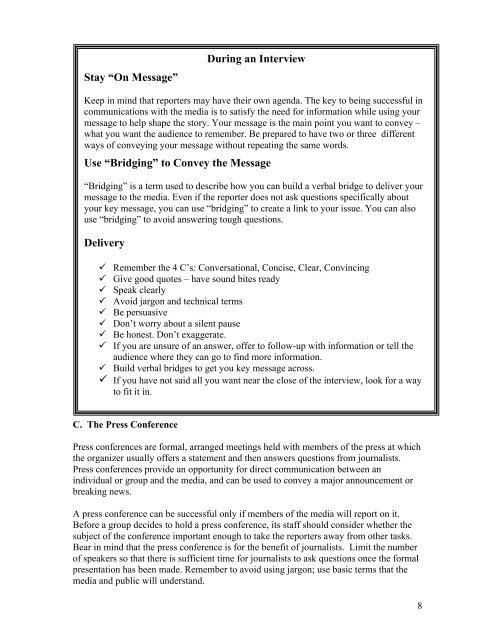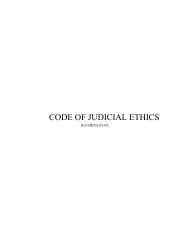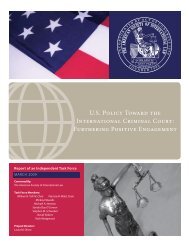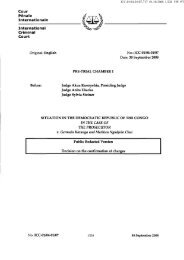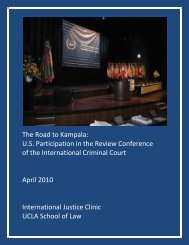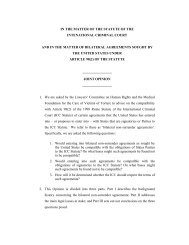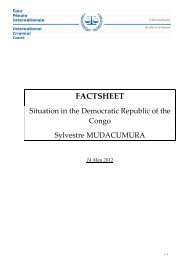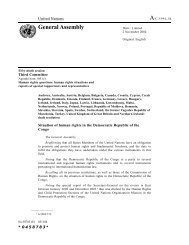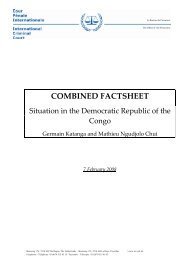NGO Media Outreach: Using the Media as an Advocacy Tool - AMICC
NGO Media Outreach: Using the Media as an Advocacy Tool - AMICC
NGO Media Outreach: Using the Media as an Advocacy Tool - AMICC
- TAGS
- using
- advocacy
- tool
- amicc
- www.amicc.org
You also want an ePaper? Increase the reach of your titles
YUMPU automatically turns print PDFs into web optimized ePapers that Google loves.
Stay “On Message”<br />
C. The Press Conference<br />
During <strong>an</strong> Interview<br />
Keep in mind that reporters may have <strong>the</strong>ir own agenda. The key to being successful in<br />
communications with <strong>the</strong> media is to satisfy <strong>the</strong> need for information while using your<br />
message to help shape <strong>the</strong> story. Your message is <strong>the</strong> main point you w<strong>an</strong>t to convey –<br />
what you w<strong>an</strong>t <strong>the</strong> audience to remember. Be prepared to have two or three different<br />
ways of conveying your message without repeating <strong>the</strong> same words.<br />
Use “Bridging” to Convey <strong>the</strong> Message<br />
“Bridging” is a term used to describe how you c<strong>an</strong> build a verbal bridge to deliver your<br />
message to <strong>the</strong> media. Even if <strong>the</strong> reporter does not <strong>as</strong>k questions specifically about<br />
your key message, you c<strong>an</strong> use “bridging” to create a link to your issue. You c<strong>an</strong> also<br />
use “bridging” to avoid <strong>an</strong>swering tough questions.<br />
Delivery<br />
� Remember <strong>the</strong> 4 C’s: Conversational, Concise, Clear, Convincing<br />
� Give good quotes – have sound bites ready<br />
� Speak clearly<br />
� Avoid jargon <strong>an</strong>d technical terms<br />
� Be persu<strong>as</strong>ive<br />
� Don’t worry about a silent pause<br />
� Be honest. Don’t exaggerate.<br />
� If you are unsure of <strong>an</strong> <strong>an</strong>swer, offer to follow-up with information or tell <strong>the</strong><br />
audience where <strong>the</strong>y c<strong>an</strong> go to find more information.<br />
� Build verbal bridges to get you key message across.<br />
� If you have not said all you w<strong>an</strong>t near <strong>the</strong> close of <strong>the</strong> interview, look for a way<br />
to fit it in.<br />
Press conferences are formal, arr<strong>an</strong>ged meetings held with members of <strong>the</strong> press at which<br />
<strong>the</strong> org<strong>an</strong>izer usually offers a statement <strong>an</strong>d <strong>the</strong>n <strong>an</strong>swers questions from journalists.<br />
Press conferences provide <strong>an</strong> opportunity for direct communication between <strong>an</strong><br />
individual or group <strong>an</strong>d <strong>the</strong> media, <strong>an</strong>d c<strong>an</strong> be used to convey a major <strong>an</strong>nouncement or<br />
breaking news.<br />
A press conference c<strong>an</strong> be successful only if members of <strong>the</strong> media will report on it.<br />
Before a group decides to hold a press conference, its staff should consider whe<strong>the</strong>r <strong>the</strong><br />
subject of <strong>the</strong> conference import<strong>an</strong>t enough to take <strong>the</strong> reporters away from o<strong>the</strong>r t<strong>as</strong>ks.<br />
Bear in mind that <strong>the</strong> press conference is for <strong>the</strong> benefit of journalists. Limit <strong>the</strong> number<br />
of speakers so that <strong>the</strong>re is sufficient time for journalists to <strong>as</strong>k questions once <strong>the</strong> formal<br />
presentation h<strong>as</strong> been made. Remember to avoid using jargon; use b<strong>as</strong>ic terms that <strong>the</strong><br />
media <strong>an</strong>d public will underst<strong>an</strong>d.<br />
8


